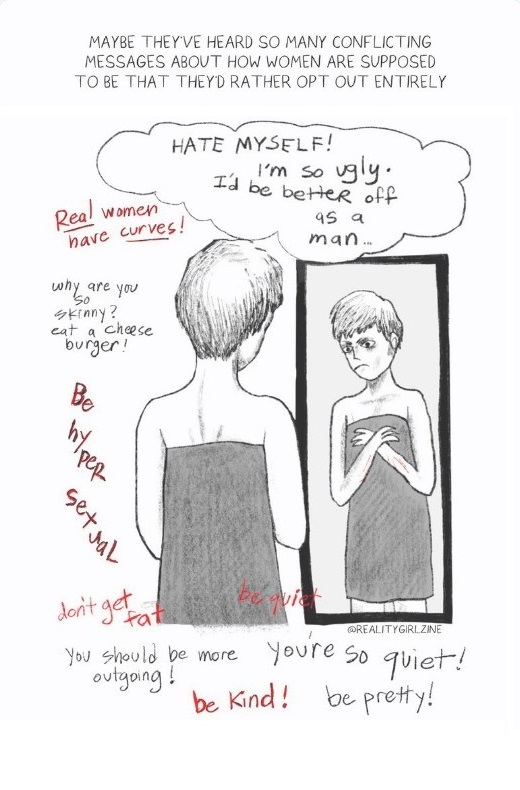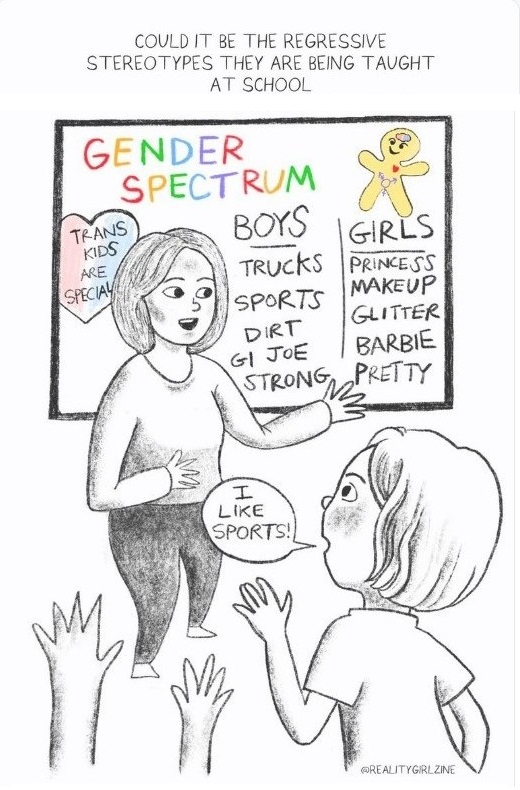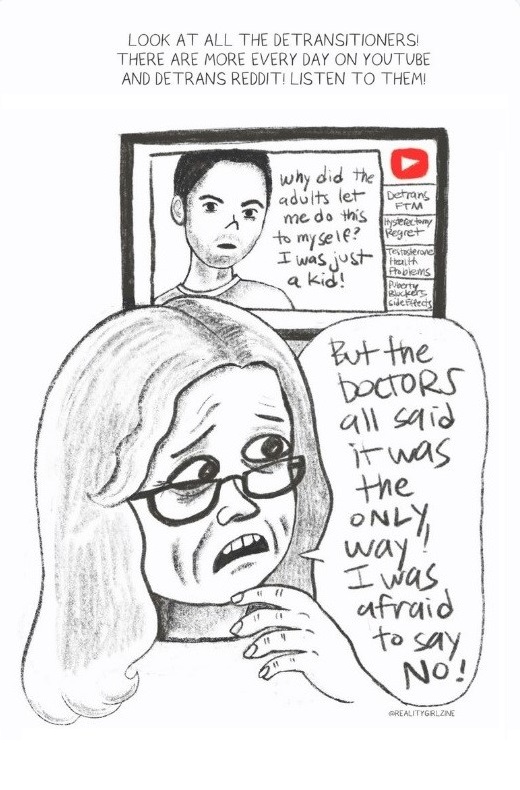CONCISE GUIDE FOR SCHOOLS
INCLUSION AND DIVERSITY, A SAFE PATHMany children suffer from feeling that as a girl or boy they do not belong in our society, especially if they do not fit into the restrictive stereotypes imposed by society. Combating stereotypes, accepting non-conformity and embracing individuality is therefore essential if we want every child to reach their full potential.
In recent years, however, a new framework of beliefs has come to the fore, in which an inner experience – a supposed innate gender identity – determines whether we are a man or a woman, or neither (non-binary). From this perspective, gender dysphoria results from a mismatch between gender identity and the physical body.
Almost inevitably, it then seems that only medical interventions are able to resolve this conflict and combat dysphoria: a “transition”, to go through life as a person of our chosen gender.
Along this path, which starts with social transition – the adjustment of first names and pronouns – we then find puberty inhibitors, cross-sex hormones and surgery. Obfuscating terms like “top surgery” or “bottom surgery” disguise the fact that we are talking about serious, irreversible procedures, such as double mastectomy or castration. The need for hormone treatment is lifelong. Each of these procedures has sexual and global health implications.
Meanwhile, there is growing concern internationally. There is no convincing evidence that this medical approach eliminates gender dysphoria or promotes mental health.
Detransitioners – people who are embracing their birth sex again – testify that other problems formed the basis of their gender confusion. They often talk about homosexuality, autism, bullying or sexual abuse.
Studies show that most adolescents with dysphoria come to terms with their birth sex if they are not put on a medical path. Puberty blockers, the next “logical” step after a social transition, hinder this spontaneous progression. Their use leads to further medical intervention in 98% of cases.
For educators, there is a heavy responsibility here. How far may they go with these young people denying their biological sex to accommodate psychological suffering without trapping them in a limited interpretation of their dysphoria?
SOME PRACTICAL PRECAUTIONS
- Give children self-confidence in their bodies. Not fitting into our normative society and not feeling accepted is a major cause of dysphoria. Teaching children and adolescents to fully accept non-conformity and diversity is therefore an important preventive measure.
- Do not rely on limiting stereotypes to make a child consider a “gender” label. Any boy who plays with dolls is a boy, any girl who likes football is a girl. It does not matter if their preferences do not match the stereotypes expected of them.
- Especially very young children have only a vague sense of identity, reality and sexuality and may confuse concepts. Do not lay the groundwork for dysphoria yourself by encouraging children to fret about their “gender”. Do not ask around about pronouns. Avoid using tools with “sliders” that suggest children are somewhere on a “spectrum”.
- Be cautious about adopting self-selected pronouns. No one should be bullied, but neither should we be celebrating transitions. Do not keep parents in the dark about a possible social transition of their child at school.
- “Gender” and “sex” are different. Stay realistic: it is impossible to “change sex” Don’t go along with children’s “magical thinking” and abandonment of the biological reality of the body.
- Give attention to the full issues of a child with dysphoria, talk to him or her about the concrete feelings and problems, and avoid simplistic reductions to “gender identity”. If necessary, refer them for professional help that is not exclusively affirmative but offers an exploratory, holistic approach.
- Do not leave education about diversity and inclusion to outside groups, especially if you suspect that they present a one-sided vision, using false suicide rates, or having an activist agenda.
- Also respect other pupils, as well as staff, and do not force them to deny or adapt their own experience of reality to that of another person in school. Do not lie to other children about someone’s birth sex, but be open and make the subject discussable. This can only benefit true acceptance.
- Everyone has an equal right to privacy and comfort. Not everyone dares to raise objections about sharing toilets, changing rooms, dormitories, etc. Keep toilets separated on the basis of sex and provide private toilets for trans-identified persons if necessary.
PANO reportage Trans teens – March 29, 2023
- At the Centre for Gender and Sexology Ghent, 1048 minors have consulted the gender clinic (2007 – 2022).
- In 2022, there were 171 new intake calls for minors. This is 42 times more than 15 years ago. The biggest increase is in the group between 13 and 20 years, and two-thirds are biological girls.
- The youngest child to start puberty inhibitors in Ghent was 10 years and 5 months old. The number of children who started pubertal inhibitors (Decapeptyl) between 2007-2022 is 88. All these children pursued a medical transition.
- In Ghent, 130 underage girls had their breasts removed over the past 15 years. This can be done from the age of 17.
“What you are doing is a pure experiment on children, with no scientific evidence for it.“
Patrik Vankrunkelsven, director of the Belgian Centre for Evidence-Based Medicine (CEBAM), PANO Trans teens
“I am not saying that there should be a barrier for people to express themselves and live their lives as the way they want. But medical intervention is a different issue from letting people be as they are.“
Riittakerttu Kaltiala, Professor of Adolescent Psychiatry, Tampere University, Finland, PANO Trans teens
Finland, Sweden, England, Norway and Denmark have already distanced themselves from the WPATH guidelines for minors, and psychotherapy is offered as the first and usually only line of treatment.
APPENDIX
RISK OF OVERDIAGNOSIS
- There is a very recent, exponential increase in transidentification during puberty (up to 3000% increase in some centres), which occurs disproportionately more often in girls (up to 80%) than in boys, while previously the ratio was reversed. This suggests that social influence plays a role in the trend.
- Gender dysphoria disproportionately affects LGB youth, children with autism, other mental health issues and trauma.
- The quasi-obligatory ‘gender affirmative’ approach is non-exploratory and focuses on “gender”. This can lead to diagnostic overshadowing, where underlying psychological problems are ignored.
- There is a growing number of detransitioners who are questioning their “trans” diagnosis.
- Gender dysphoria resolves in an average of 80% of cases after puberty, if no medical treatment is instituted.
DOUBTS ABOUT SAFETY AND EFFICACY
- Puberty blockers do not appear to be just a “pause button” that provides time for reflection. In 98% of cases they put children on the path to hormones of the opposite sex. They also have negative side effects and the long-term effects are still unknown.
- A review study has shown that these medical interventions have only weak evidence and have not proven their safety.
EMOTIONAL PRESSURE
The pressure is on. Educators must contend with an activist “community”, online and elsewhere, that poses as “new family”, downplays the dangers, and portrays concerned parents as “transphobic” and unloving. Tips are also shared, such as addresses where to hormones can be obtained, or the advice to play the suicide card to get parents and therapists to go along with the transition wish.
But statements like “Would you rather have a living daughter, or a dead son?” should be seen for what they are: manipulative. Suicide is in reality an extremely rare occurrence. A study of persons with gender dysphoria put the death rate from suicide at 0.6%, which is in line with other figures for adolescent suffering. This contradicts the often put forward figure of 45% in gender dysphoria. Moreover, there is no evidence that medical transition would reduce this risk (Sami-Matti Ruuska et al, 2024).
While we must pay full attention to the words of a young person with pronounced psychological distress, we must also be careful not to lock them into a narrow interpretation of their dysphoria.
Too quick a focus on “gender” may unintentionally deprive these young people of an opportunity to accept their sexual orientation or to causally address other mental health issues.
TOWARDS A CAREFUL WAITING POLICY
An affirmation of “being trans” begins with social transition. This often happens at school, sometimes without the parents’ knowledge. This places a heavy responsibility on the shoulders of educators. To what extent should they go along with this?
There is no single study that can confirm the existence of innate transidentity. What we already know: Research at the Tavistock Gender Clinic confirms that social transition among young people does not provide any overall benefits for mental health. Instead, it leads to a “lock-in” of gender identity and thus increases the risk of unnecessary medicalisation. Affirming social transition, including changing pronouns, is therefore a powerful psychosocial intervention, which is not within the remit of educators in school.
A cautious wait-and-see school policy leaves the treatment of mental health problems to professionals with a broad view of dysphoria, and does not place impossible responsibility on educators.
FOR FURTHER INFORMATION
- The Gender Framework is a comprehensive work on the deeper understanding of gender and identity, pointing away from the medicalised approach to gender issues towards a direction of social, psychological and cultural solutions.
- Stats for Gender has an overview of thorough studies that provide answers to various questions, classified by topic.
- ZEMBLA The transgender protocol – This Dutch documentary is shaking gender medicine to its foundations.
- Reddit/detrans has an insight into the disillusionment, grief and despair of detransitioners.






